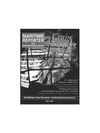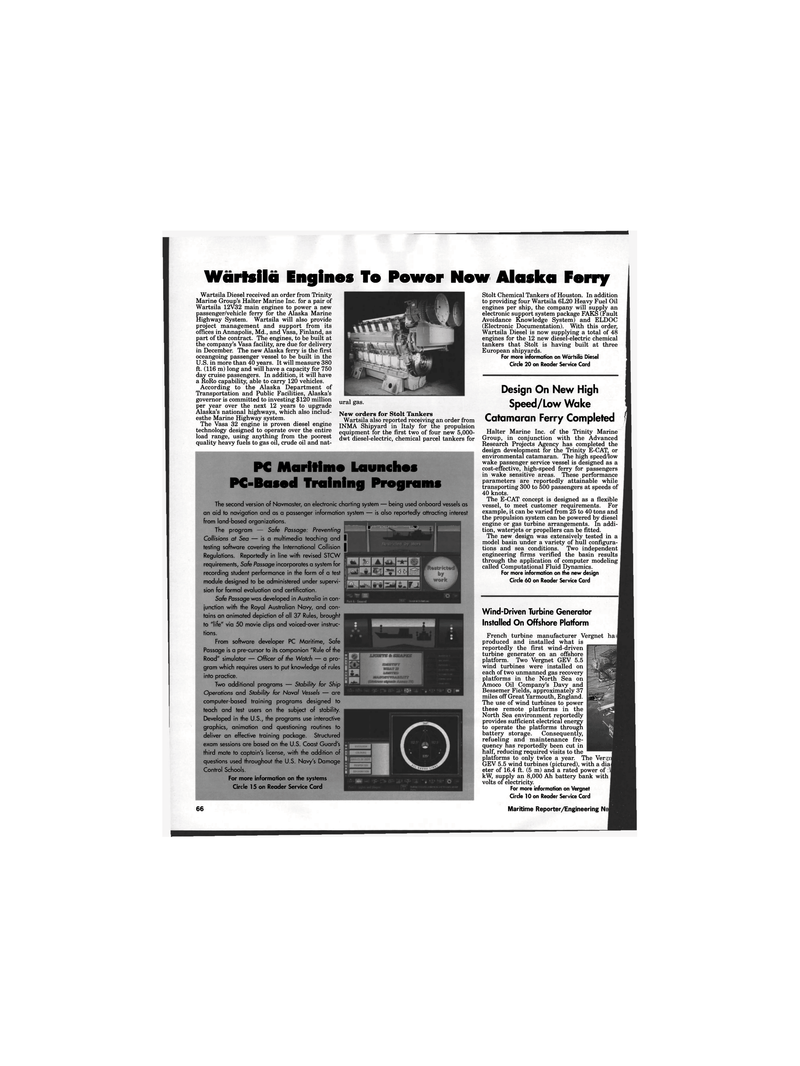
Page 64: of Maritime Reporter Magazine (July 1996)
Read this page in Pdf, Flash or Html5 edition of July 1996 Maritime Reporter Magazine
Wartsila Engines To Power Now Alaska Ferry
Wartsila Diesel received an order from Trinity
Marine Group's Halter Marine Inc. for a pair of
Wartsila 12V32 main engines to power a new passenger/vehicle ferry for the Alaska Marine
Highway System. Wartsila will also provide project management and support from its offices in Annapolis, Md., and Vasa, Finland, as part of the contract. The engines, to be built at the company's Vasa facility, are due for delivery in December. The new Alaska ferry is the first oceangoing passenger vessel to be built in the
U.S. in more than 40 years. It will measure 380 ft. (116 m) long and will have a capacity for 750 day cruise passengers. In addition, it will have a RoRo capability, able to carry 120 vehicles.
According to the Alaska Department of
Transportation and Public Facilities, Alaska's governor is committed to investing $120 million per year over the next 12 years to upgrade
Alaska's national highways, which also includ- esthe Marine Highway system.
The Vasa 32 engine is proven diesel engine technology designed to operate over the entire load range, using anything from the poorest quality heavy fuels to gas oil, crude oil and nat- ural gas.
New orders for Stolt Tankers
Wartsila also reported receiving an order from
INMA Shipyard in Italy for the propulsion equipment for the first two of four new 5,000- dwt diesel-electric, chemical parcel tankers for
Stolt Chemical Tankers of Houston. In addition to providing four Wartsila 6L20 Heavy Fuel Oil engines per ship, the company will supply an electronic support system package FAKS (Fault
Avoidance Knowledge System) and ELDOC (Electronic Documentation). With this order,
Wartsila Diesel is now supplying a total of 48 engines for the 12 new diesel-electric chemical tankers that Stolt is having built at three
European shipyards.
For more information on Wartsila Diesel
Circle 20 on Reader Service Card
Design On New High
Speed/Low Wake
Catamaran Ferry Completed
Halter Marine Inc. of the Trinity Marine
Group, in conjunction with the Advanced
Research Projects Agency has completed the design development for the Trinity E-CAT, or environmental catamaran. The high speed/low wake passenger service vessel is designed as a cost-effective, high-speed ferry for passengers in wake sensitive areas. These performance parameters are reportedly attainable while transporting 300 to 500 passengers at speeds of 40 knots.
The E-CAT concept is designed as a flexible vessel, to meet customer requirements. For example, it can be varied from 25 to 40 tons and the propulsion system can be powered by diesel engine or gas turbine arrangements. In addi- tion, waterjets or propellers can be fitted.
The new design was extensively tested in a model basin under a variety of hull configura- tions and sea conditions. Two independent engineering firms verified the basin results through the application of computer modeling called Computational Fluid Dynamics.
For more information on the new design
Circle 60 on Reader Service Card
Wind-Driven Turbine Generator
Installed On Offshore Platform
French turbine manufacturer Vergnet ha produced and installed what is reportedly the first wind-driven turbine generator on an offshore platform. Two Vergnet GEV 5.5 wind turbines were installed on each of two unmanned gas recovery platforms in the North Sea on
Amoco Oil Company's Davy and
Bessemer Fields, approximately 37 miles off Great Yarmouth, England.
The use of wind turbines to power these remote platforms in the
North Sea environment reportedly provides sufficient electrical energy to operate the platforms through battery storage. Consequently, refueling and maintenance fre- quency has reportedly been cut in half, reducing required visits to the platforms to only twice a year. The Ver
GEV 5.5 wind turbines (pictured), with a dia eter of 16.4 ft. (5 m) and a rated power of 1 kW, supply an 8,000 Ah battery bank with volts of electricity.
For more information on Vergnet
Circle 10 on Reader Service Card ifi i ^
PC Maritime Launches
PC-Based Training Programs
The second version of Navmaster, an electronic charting system — being used onboard vessels as an aid to navigation and as a passenger information system — is also reportedly attracting interest from land-based organizations. P«niRn|pnpHgjmP^
The program — Safe Passage: Preventing
Collisions at Sea — is a multimedia teaching and I testing software covering the International Collision |
Regulations. Reportedly in line with revised STCW requirements, Safe Passage incorporates a system for recording student performance in the form of a test module designed to be administered under supervi- sion for formal evaluation and certification.
Safe Passage was developed in Australia in con- junction with the Royal Australian Navy, and con- tains an animated depiction of all 37 Rules, brought to "life" via 50 movie clips and voiced-over instruc- tions.
From software developer PC Maritime, Safe
Passage is a pre-cursor to its companion "Rule of the
Road" simulator — Officer of the Watch — a pro- gram which requires users to put knowledge of rules into practice.
Two additional programs — Stability for Ship
Operations and Stability for Naval Vessels — are computer-based training programs designed to teach and test users on the subject of stability.
Developed in the U.S., the programs use interactive graphics, animation and questioning routines to deliver an effective training package. Structured exam sessions are based on the U.S. Coast Guard's third mate to captain's license, with the addition of questions used throughout the U.S. Navy's Damage
Control Schools.
For more information on Hie systems
Circle 15 on Reader Service Card 66 Maritime Reporter/Engineering N

 63
63

 65
65
